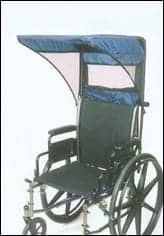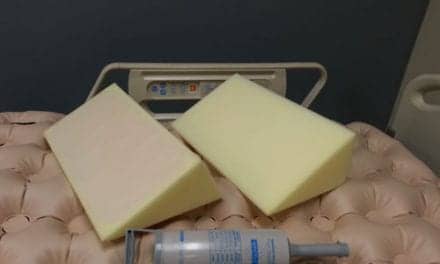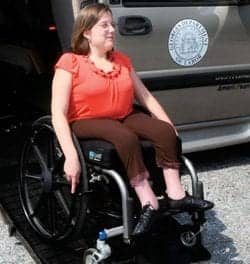So many types, brands, and models of wheelchair accessories exist that any attempt to catalog them all would yield a document too big to pick up off your desk without the aid of a forklift.
An exaggeration, of course. But a visit to the Internet reveals a dizzying array of basic convenience gizmos alone: trays, cup holders, fishing pole stanchions, cell phone compartments, laptop workstations, carry-all bags, under-the-chair storage nets, gloves, umbrellas, oxygen tank holders, and threshold ramps.
Joining those at this same site are accessories such as rims, rim covers, spoke covers, brake-lock extension arms, stabilizers, anti-rollback mechanisms, armrests, and footrests. In the section devoted to wheelchair cushions are air cushions, amputee cushions, bariatric cushions, foam cushions, gel cushions, lap cushions, pommel cushions, saddle cushions, support pro cushions, and wedge cushions. Navigate over to the listings for positioning systems, and you find backrests, drop seats, ankle-and-foot protectors, back systems, and belts. Then look at support systems. These are broken into pages for head supports, back supports, lateral supports, leg supports, and foot supports.
WORTHY OF NOTE
It is enough to drive one to distraction. To the rescue is this handy roundup of accessories—those causing the most stir in the world of mobility.
 |
| A wheelchair canopy can provide protection from the elements. |
From a Bozeman, Mont, company comes a head stabilizing unit with moldable support fingers that can be adjusted vertically to provide a customized fit. Optional is a sheepskin neck pad for added comfort and decreased friction and shear. The same company also offers a fully adjustable lateral support recommended for users whose ability to maintain posture is moderately to severely impaired. The product features all-steel construction and comes with either standard or contoured lateral pads that adjust horizontally or vertically.
Another manufacturer based in Mukilteo, Wash, makes headrests that allow for optimal positioning of height, fore, aft, angles, and tilt. These come with either a plush pad or low profile pad and can be procured with the company’s base for additional lateral adjustment. The supplied mounting brackets adjust easily to accommodate changes or inconsistencies in body positioning. This manufacturer also offers a positioning unit for the pelvis, which is a dynamic, swing-away device that eliminates the need for a lap belt or a more traditional bar. The device readily mounts to most wheelchair seats and employs “floating” elliptical pads that conform to body contours while applying comfortable but appropriate control pressure. Six-way adjustable hardware provides a convenient means of pinpointing pelvic support. The swing-away aspect affords unhindered access for transfers. Meanwhile, a pressure lock system prevents unintentional release of the support pads under load.
 |
| Stump supports can add comfort and stability for amputees. |
Agitated users might like a tray that features a water-based gel surface (made by a company in Yonkers, NY) that is said to help decrease restlessness, as users can knead its smooth, cool surface. Bright star shapes are visible through the vinyl cover—they move through the gel and are visually satisfying. The gel surface also helps relieve pressure on sensitive arms and elbows. Fits all full-arm 16-inch and 18-inch-wide wheelchairs.
SIT IN COMFORT, SECURITY
Cushions filled in a novel manner by chambered air is the claim to fame of a Belleville, Ill-based mobility manufacturer, which recently released a customized, contoured cushion. The product is said to promote postural stability, maximize function, and maintain skin integrity. It is designed to work in tandem with the company’s memory control unit: the cushion’s contoured design positions the pelvis back in the wheelchair, and the memory control feature locks air into each of four quadrants. This serves to minimize side-to-side and front-to-back motion.
 |
| High-tech control systems offer a variety of environmental control and navigation solutions. |
Two other intriguing accessories from the company are a sacral support cushion and a lumbar support cushion. The sacral support product is custom-designed to the user’s specification and is available in 1- to 4-inch cell heights; it weighs approximately 1 pound. The back-pain-relieving lumbar support cushion, meanwhile, can be custom-designed or purchased off-the-shelf. Its standard cell height is 4 inches.
Among the multiple wheelchair accessory lines offered by a Baltimore-based manufacturer are boxes to protect and support the feet. The company’s standard model foot box is constructed of four pieces fashioned from upholstered plywood and foam. A heavy-duty model features stronger brackets, and a variant model replaces the plywood with ABS plastic.
The company also produces a switch for the operation of environmental control systems, computers, and augmentative communication devices. The tough but quiet and water-resistant switch is ideal for harsh or abusive conditions. It has a soft, urethane base and molded silicone cover, which make it ideal in circumstances calling for activation by contact with the wheelchair user’s face. This switch is supplied with a 6-foot cord and male phono jack.
 |
| Contoured lateral supports systems are available in a variety of dimensions. |
In addition, the manufacturer is a producer of wheelchair seating and positioning products that include a line of pediatric hardware and seating, custom molded seating, and a line of soft secondary supports. Relatively new is its all-custom back support system. It is designed to fit between the wheelchair’s uprights; the mounting hardware provides for a combined 21/4 inches of anterior-posterior depth adjustment and 15 degrees of back angle adjustment. Adjustable swing-away anterior laterals can accommodate patient thoracic widths between a half-inch and 61/2 inches less than the width of the wheelchair. They come in sizes from 14 inches to 25 inches wide and 12 inches to 28 inches high. A three-piece cover design allows independent adjustment of the back’s laterals.
A Spicewood, Tex-based company also offers a variety of high-tech mobility and communications solutions—including drive control packages, modifiers, adaptors, electronic switches, etc—that provide disabled individuals access to computers, environmental control interfaces, and other products for daily living.
 |
| Neck supports are ideal for individuals with weak necks or poor head control. |
GOOD TIMES ROLL
An Ann Arbor, Mich, company offers a new high-tech addition to its family of head supports. Formed of soft foam, the collar wraps around the neck of the user with minor to moderate head support needs, and is designed to facilitate easy head movement from side to side. And because it is not attached, the collar can be used with any seating system. However, it is contraindicated for adults and children who are trached and for those who have breathing or swallowing disorders. Custom options include extended collar length, thicker side foam, blue or pink covers, and white or dark gray foam. Also sold are foam plugs that fit into the collar’s ventilation holes—these give firmer support for clients who tend to lean in one direction or drop their heads forward.
Canopies are a specialty of a Chico, Calif, manufacturer, which also crafts armrest bags, seat-back bags, covers, equipment holders, trays, and threshold ramps. The company offers a hood that mounts to the back of a wheelchair in order to protect the user from sun and rain. The product comes in three versions. The base model has a fabric top that extends down the back and partially covers the sides. A vented model to help keep the wheelchair user cool replaces the solid fabric on the sides with an open-weave, see-through mesh material and adds a cutout window in the back, also covered with the same mesh fabric. A variation on the vented model features clear plastic panels that drop down from the top and extend to the seat to more completely shield the wheelchair user from inclement weather.
 |
| A foam base and sealed air support pad enhance this wheelchair cushion. |
A company in Burnet, Tex, is known for its powered tilt seating system to relieve pressure, shift position, improve swallowing, and reposition line of sight for users of either manual or power wheelchairs. It also makes alternative technology such as switches, mushroom joysticks, and joystick collar-mounting systems. Among its newest products is a head and neck positioning system that is intended to address challenges involved in achieving active head control, as well as improve eye contact. Doing so promotes person-to-person interactivity and sociability. Other benefits: the system makes feeding easier, increases saliva management (and decreases drooling), reduces time expended by caregivers on repositioning, and enhances the ability of the wheelchair user to communicate and interpret responses. It comes standard with a chin prompt to promote more neutral head positioning and help limit neck flexion. Standard too are link hardware and a flip-down feature. The head and neck positioning unit is seen as ideal for wheelchair users too weak to long hold up their heads and for those with significant extensor tone but poor head control (a circumstance often resulting in the head becoming caught under the headrest or to the side of it and requiring constant repositioning by the caregiver).
 |
| An adjustable tray can provide a work, activity, or eating space for the user. |
HANG ON TIGHT
Headrests and neckrests are useless unless somehow bolted to the wheelchair. Among the many products made by a Minneapolis-based manufacturer are mounting and attachment components to permit exactly that. Mounts come in two multiaxis types: straight and offset in a choice of chrome or black. Also available is a headrest adapter kit, which attaches by means of STS clamps to the wheelchair’s upper rear frame; the adapter’s design is such that it does not interfere with chair folding. Alternatively, the company’s clinical headrest mounting kit that clamps instead to the wheelchair’s push handles may be used on chairs with a seat width of 16 inches to 24 inches. This manufacturer’s full range of wheelchair accessories includes headrests, neckrests, thoracic supports, armrests, hand pads, foot buckets, calf rests, and legrests. The company also makes a variety of customized seat and back cushions and inserts for adults and children. Popular too are the company’s triad of rigid but adjustable wheelchair backs incorporating a material that combines the fluidity of gel with the feathery lightness of foam. One of these backs provides mild lateral support for positioning and has contour lines that preserve upper body range of motion, while a second back offers deep lateral side support for users who require more aggressive upper body control. The remaining back features several customization options for very involved users.
 |
| This seating system is available with a pressure gauge and an alarm system. |
Recently added to the line of accessories from an Exeter, Pa-based manufacturer is an interior lift. Engineered to fit sport utility vehicles and a range of others with an opening height of at least 31 inches, this low-profile, angled-platform lift features all-steel construction and a protective finish. It is delivered with an industrial-rated 12-volt motor and battery pack, plus easy-to-use two-button hand controls. Available through the company is a collection of drive controls—among them drive technology products that employ fully programmable “plug and play” joystick- or buddy button-based boxes to control drive functions, power seating systems, environmental controls, and augmentative communication devices. These are sold alongside the company’s fully programmable drive control system, which features a special display of information about speed, battery condition, mileage, and elapsed time.
New from a company in Seattle is a general use back system. The lightweight and user-friendly system delivers upper body support to wheelchair users who require more support than that which a conventional sling-back system can provide. Comfort is supplied by an adjustable air-foam floatation cushion. The system incorporates the company’s proprietary back-system hardware for quicker, easier installation—adjustments even can be made with the user in the wheelchair. It is available in widths from pediatric to bariatric, and in heights including regular and tall. Another product from this company is an air-filled cushion for users at moderate risk of skin breakdown. The cushion features a built-in mechanism (patent pending) that—when the user sits—releases precisely enough air to allow a fixed amount of immersion. Notably, the immersion conforms to the user’s body and contributes to stabilization while also preventing bottoming out. When weight is taken off the cushion, it automatically re-inflates.
What will they think of next?
Rick Romano is a contributing writer for Rehab Management. For more information, please contact .
For Your Mobility Needs
Looking for mobility accessories? Here are some vendors to contact:
- Adaptive Switch Labs (www.asl-inc.com)
- The A.R.T. Group (www.artgrouprehab.com), a division of Sunrise Medical
- Body Tech NM (www.bodytechnw.com), Mukilteo, Wash
- The Comfort Company (www.comfortcompany.com), Bozeman, Mont
- Danmar Products (www.danmarproducts.com), Ann Arbor, Mich
- Diestco Manufacturing Corp (www.diestco.com), Chico, Calif
- HealthMegaMall.com
- Otto Bock Healthcare (www.ottobockus.com), Minneapolis
- Pride Mobility Products Corp (www.pridemobility.com), Exeter, Pa
- The Roho Group (www.therohogroup.com), Belleville, Ill
- RehabiliTech of Kansas City, Kan
- Skil-Care Corp (www.skil-care.com), Yonkers, NY
- Stealth Products (www.stealthproducts.com), Burnet, Tex
- Varilite (www.varilite.com), Seattle
- Whitmyer Biomechanix of Tallahassee, Fla





